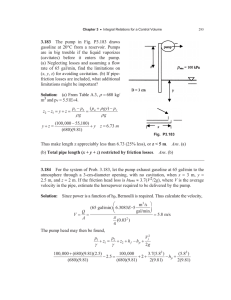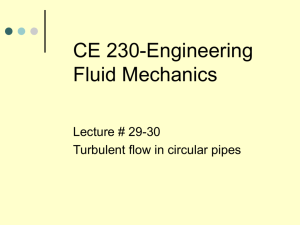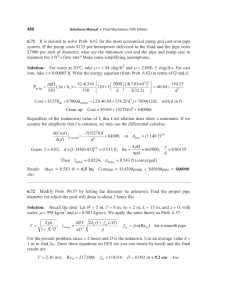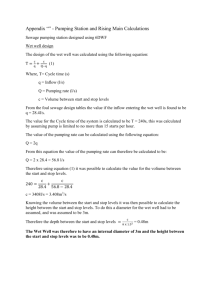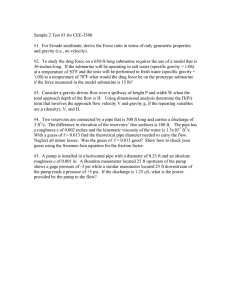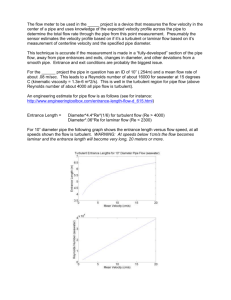Document
advertisement
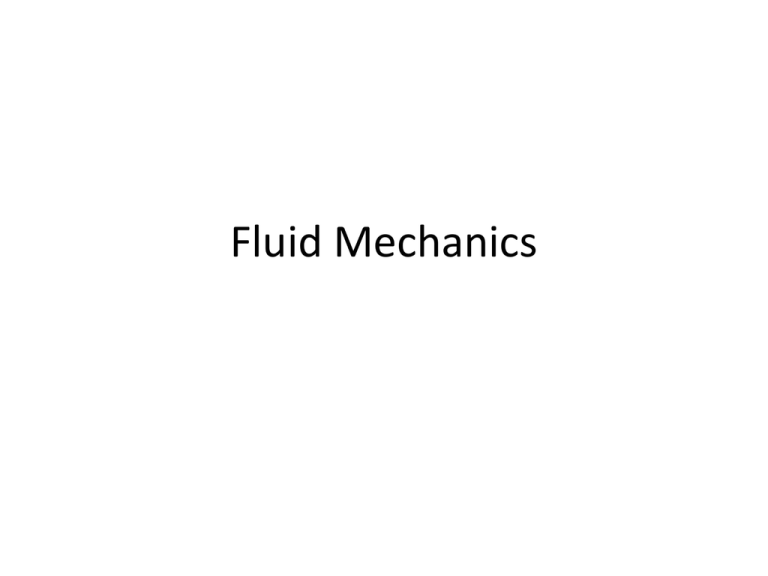
Fluid Mechanics Component Head Loss The Minor Loss Coefficient, K:- Combined Head Loss Equation (Total head loss)=(Pipe head Loss)+(Component head loss) ℎ𝐿 = = 𝑣2 2∗𝑔 𝑝𝑖𝑝𝑒𝑠 𝑓 ∗ ∗ 𝐿 𝐷 𝑝𝑖𝑝𝑒𝑠 𝑓 𝑣2 ∗ ( )+ 𝑐𝑜𝑚𝑝𝑜𝑛𝑒𝑛𝑡𝑠 𝐾 2∗𝑔 𝐿 ∗ ( ) + 𝑐𝑜𝑚𝑝𝑜𝑛𝑒𝑛𝑡𝑠 𝐾 𝐷 ∗ 𝑣2 ( ) 2∗𝑔 Example If oil (ν = 4 × 10-5 m2/s; S = 0.9) flows from the upper to the lower reservoir at a rate of 0.028 m3/s in the 15 cm smooth pipe, what is the elevation of the oil surface in the upper reservoir? Solution Minor head loss coefficients:entrance = Ke = 0.5 bend = Kb = 0.19 outlet = KE = 1.0 Π 3.14 𝐴𝑝 = ∗ 𝑑𝑝2 = ∗ 0.152 = 0.01766𝑚2 4 4 𝑄 0.028 𝑣= = = 1.58𝑚/𝑠 𝐴𝑝 0.01766 𝑉 ∗ 𝐷 1.58 ∗ 0.15 𝑅𝑒 = = = 5925 −5 𝑣 4 ∗ 10 The flow is turbulent Assume e=0 0.25 𝑓= = 𝑒 5.74 2 (log10 ( + 0.9 )) 3.7 ∗ 𝐷 𝑅𝑒 0.25 = 0.036 5.74 (log10 ( 0 + ( )))^2 0.9 5925 Head Loss:ℎ𝐿 = 𝑣2 2∗𝑔 ∗ 𝑝𝑖𝑝𝑒𝑠 𝑓 ∗ 𝐿 ( )+ 𝐷 𝑐𝑜𝑚𝑝𝑜𝑛𝑒𝑛𝑡𝑠 𝐾 ℎ𝐿 1.582 = 2 ∗ 9.80 197 ∗ 0.036 ∗ + 2 ∗ 0.19 + 0.5 + 1 0.15 ℎ𝐿 = 6.255𝑚 𝑃1 ɣ + 𝑧1 + 𝑣12 2∗𝑔 + ℎ𝑝 = 𝑃2 + ɣ 𝑧2 + 𝑣22 2∗𝑔 + ℎ𝑡 + ℎ𝐿 Where Hp=ht=0 V1=v2=0 P1=P2=Patm=0 𝑧1 = 𝑧2 + ℎ𝐿 = 130 + 6.25 = 136.25𝑚 Non-Round Conduits If the conduit is not a pipe it is a square, triangle or any other shapes we replace the diameter by the hydraulic diameter. 4 ∗ 𝐶𝑟𝑜𝑠𝑠 𝐴𝑟𝑒𝑎 𝐷ℎ = 𝑊𝑒𝑡𝑡𝑒𝑑 𝑝𝑒𝑟𝑖𝑚𝑒𝑡𝑒𝑟 For Example and rectangular tube with L(Length) and W(wide) the hydraulic diameter will be:4∗𝐿∗𝑊 2∗𝐿∗𝑊 𝐷ℎ = = 2(𝐿 + 𝑊) (𝐿 + 𝑤) Example Air (T = 20°C and p = 101 kPa absolute) flows at a rate of 2.5 m3/s in a horizontal, commercial steel, HVAC duct. (Note that HVAC is an acronym for heating, ventilating, and air conditioning.) What is the pressure drop in inches of water per 50 m of duct? Solution 𝐴 = 𝐿 ∗ 𝑊 = 0.6 ∗ 0.3 = 0.18𝑚2 𝑄 2.5 13.89𝑚 𝑣= = = 𝐴 0.18 𝑠 4∗𝐿∗𝑊 4 ∗ 0.6 ∗ 0.3 𝐷ℎ = = = 0.4𝑚 2 ∗ (𝐿 + 𝑊) 2 ∗ (0.6 + 0.3) 𝑉 ∗ 𝐷ℎ 13.89 ∗ 0.4 𝑅𝑒 = = = 368000 −6 𝑣 15.1 ∗ 10 The flow is turbulent 𝑒 = 0.000046𝑚 0.25 𝑓= = 𝑒 5.74 2 (log10 ( + 0.9 )) 3.7 ∗ 𝐷ℎ 𝑅𝑒 0.25 0.000046 5.74 (log10 (( )+( )))^2 0.9 3.7 ∗ 0.4 368000 = 0.015 𝐿 𝑣2 ℎ𝐿 = 𝑓 ∗ ∗ 𝐷ℎ 2∗𝑔 50 13.892 = 0.015 ∗ = 18.6𝑚 0.4 2 ∗ 9.81 𝑃𝑙𝑜𝑠𝑠 = ρ ∗ 𝑔 ∗ ℎ𝐿 = 1.2 ∗ 9.814 ∗ 18.6 = 220𝑃𝑎 1000 ∗ 9.81 ∗ ℎ𝑤 = 220 ℎ𝑤 = 0.0224𝑚 = 2.24𝑐𝑚 = 0.883𝑖𝑛𝑐ℎ Pumps a centrifugal pump is a machine that uses a rotating set of blades situated within a housing to add energy to a flowing fluid. Pump Curve Example A pump is to be used to transfer crude oil (! = 2 × 10!4 lbf-s/ft2, 1 = 0*86) from the lower tank to the upper tank at a flow rate of 100 gpm. The loss coefficient for the check valve is 5.0. The loss coefficients for the elbow and the inlet are 0.9 and 0.5, respectively. The 2-in. pipe is made from commercial steel (e = 0*002in.) and is 40 ft long. The elevation distance between the liquid surfaces in the tanks is 10 ft. The pump efficiency is 80%. Find the power required to operate the pump. Solution Pipes in Parallel The Losses is equal in both branches as the energy different in point (1) and point (2) is equal according to Energy equation. ℎ𝐿1 = ℎ𝐿2 𝐿1 𝑣12 𝐿2 𝑣22 𝑓1 ∗ ∗ = 𝑓2 ∗ ∗ 𝐷1 2∗𝑔 𝐷2 2∗𝑔 𝑉1 2 𝑓2 ∗ 𝐿2 ∗ 𝐷1 ( ) = 𝑉2 𝑓1 ∗ 𝐿1 ∗ 𝐷2 𝑉1 𝑓2 ∗ 𝐿2 ∗ 𝐷1 1/2 =( ) 𝑉2 𝑓1 ∗ 𝐿1 ∗ 𝐷2 Example A piping system consists of parallel pipes as shown in the following diagram. One pipe has an internal diameter of 0.5 m and is 1000 m long. The other pipe has an internal diameter of 1 m and is 1500 m long. Both pipes are made of cast iron (e = 0.26 mm). The pipes are transporting water at 20C (ρ= 1000 kg/m3, v= 10^-6 m2/s). The total flow rate is 4 m3/s. Find the flow rate in each pipe and the pressure drop in the system. There is no elevation change. Neglect minor losses. Solution Take 𝑓1 = 0.017 𝑎𝑛𝑑 𝑓2 = 0.0145 𝑎𝑠 𝑖𝑛𝑖𝑡𝑎𝑙 𝑔𝑢𝑒𝑠𝑠
